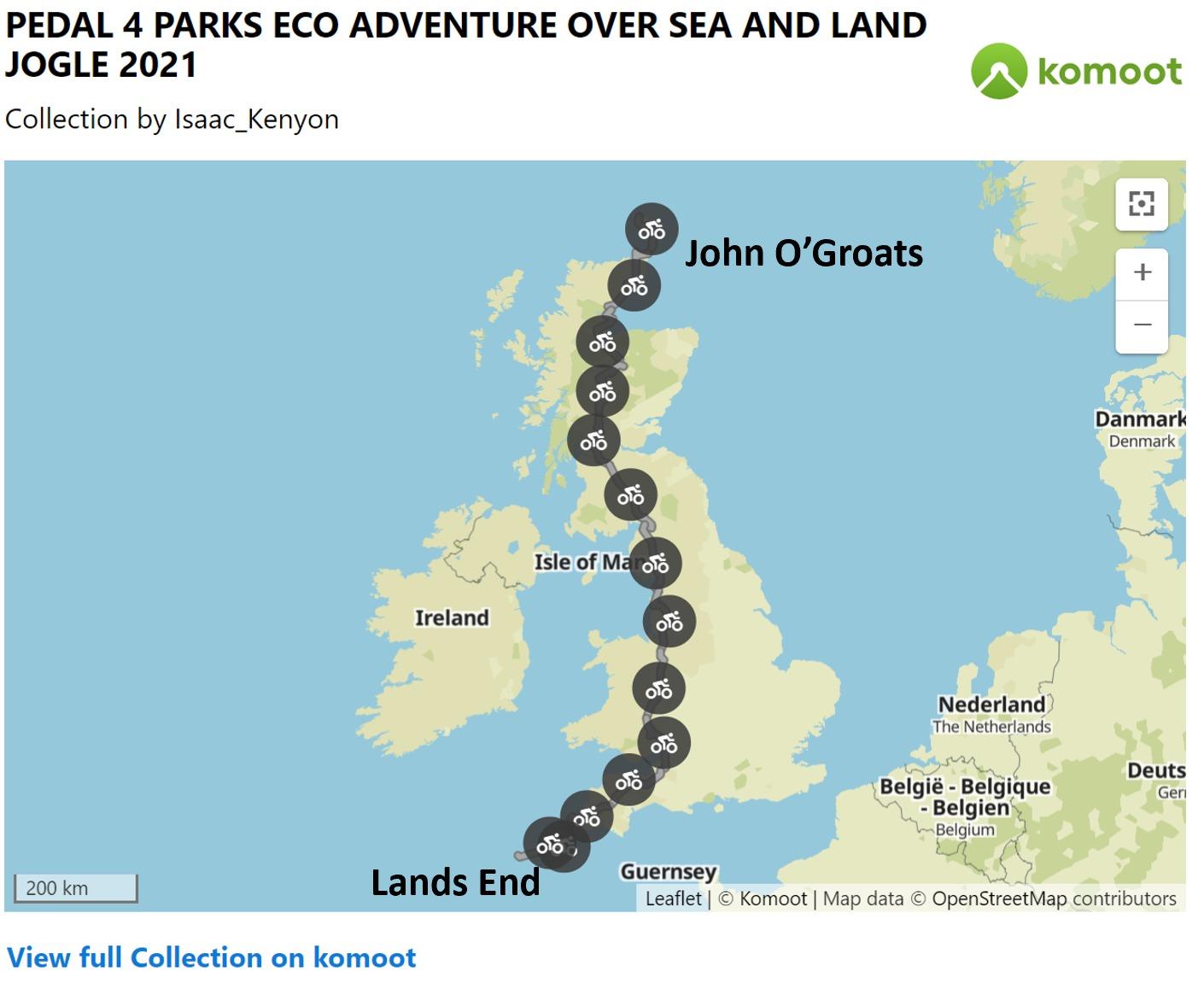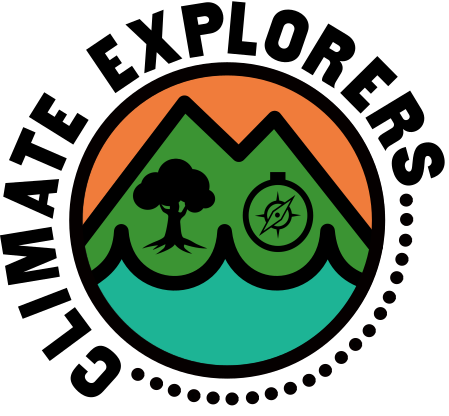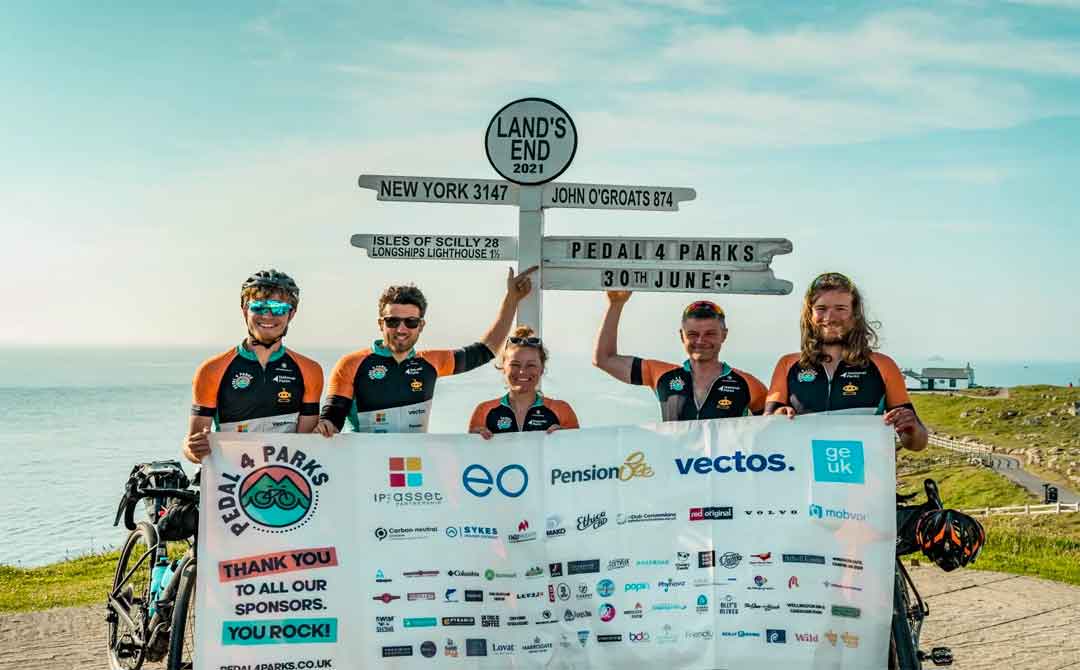
Pedaling North to South: The Route of our Environmental Pursuit
In June 2021, Pedal 4 Parks will be setting off on a 1,200 mile journey across the UK. The team of five eco-warriors will be travelling across land and sea from the Orkney Islands to the Isles of Scilly in a world’s first cycling expedition.
Along the way our team will be visiting some of the UK’s National Parks and talking to a variety of environmental and sustainable innovators to find out what we can do to curb environmental decline and preserve green space for the benefit of nature and humanity. The places and people we visit will be crucial in the creation of our documentary, thus our itinerary is formed on our educational journey, not the quickest route available.
Working with Komoot we have mapped out our entire journey! Click on the link here or on the image below to explore the journey in more detail and see the exact locations we will be visiting! You will also be able to follow the team live as they cycle on an interactive map that is currently being built by ZeroSixZero.
Our Komoot Route (Access Via this Link)
National Parks
National Parks UK has teamed up with Pedal 4 Parks on our mission to educate the nation on why we need to preserve these beautiful spaces and the scalable solutions available to do so. Not only are we supporting National Parks through our educational aims, we are also raising money to help fund the upkeep and preservation of these areas of stunning natural beauty.
The UK has a total of 15 national parks. England hosts 10 of the parks that cover 9.3% of the land area, Wales has 3 parks covering 19.9% of the country and Scotland is home to the last two that cover 7.3% of the nation. On this journey, the Pedal 4 Parks team will be cycling through 6 of them. From North to South these will be: the Cairngorms, Loch Lomond and the Trossach, the Lake District, Brecon Beacons, Exmoor and Dartmoor. These spaces will offer our team the opportunity to capture the outstanding beauty of the UK environment and open their eyes even more to the important links between green space and mental health. There is no better way to understand the challenges faced in these spaces than experiencing them first hand, all of which will be integrated into our documentary “14 Days South: Over Land and Sea”.
Take a look below at the National Parks that Pedal 4 Parks shall be visiting during their expedition!
The Cairngorms National Park is one of the largest National Parks within the UK, forming 4,500 km² of land which makes up more than the Lake Districts and Loch Lomond and the Trossachs all put together, and attracts over 1.92 million visitors every year. Not only is it huge, but half of the National Park is also designated as being of European importance for conservation. The Cairngorms is made up of a multitude of beautiful landscapes, from wildest lands to artic-like mountain plateaux, and pine forests, naming it one of the best places in the country for nature (and is even known for being the home to 80% of our capercaillie population!). If you are fond of wildlife, in particular, bird spotting, Cairngorms is one of top places to visit to witness the extensive ground-nesting of birds including Ptarmigan and Dotterel, Red Grouse and Golden Plovers, Lapwings, Oystercatchers, Redshanks, and Curlew (just to name a few!). Of course, to make sure you are aware of how to avoid these nesting grounds while exploring Cairngorms, visit their website here, for information on what you can do to help! Over a quarter of the UK’s rare and threatened species are found in the Cairngorms National Park, including the Capercaillie, the Mountain Hare, and the Scottish Wildcat (which is now rarer than the Bengal Tiger). Conservation here is therefore a vital part of the Parks’ survival, with funding from the Cairngorms Nature Action Plan supporting woodland expansion, peatland restoration, river re-naturalisation, nature-friendly farming, species conservation, and involving and engaging people in nature. To see how these plans have been implemented, and to follow the National Parks progress in this goal, click here to read all about it!
The Loch Lomond and the Trossachs National Park officially became fully operational in July 2002 when opened by Princess Anne. The Park expands across 1,865 km2 of land and has a population of 15,168 people living in its beautiful landscape. The park also contains 21 mountains, all reaching above 3,000ft tall, with the tallest being Ben More at 1,174m, has 22 larger lochs with numerous smaller lochs and lochans, is home to two forest parks – the Queen Elizabeth in the Trossachs and Argyll in Cowal, and contains one of the UK’s largest National Nature Reserves (The Great Trossachs Forest). Loch Lomond and the Trossachs is home to a variety of wildlife, including some that travel a long distance to use Scotland’s landscapes as it’s home. This variety includes golden eagles and wintering wildfowl such as the whooper swans and goldeneyes, some red deer that can be found in the Breadalbane area of the National Park, red squirrels in Cowal, and black grouse in the Trossachs. As home to many valuable members of the wildlife family, conservation and regeneration is an important part of the Loch Lomond and the Trossachs long-term plan for the National Park (named the Wild Park 2020 – read more here, about this long-term vision towards the protection of the Park). To find out more about how the National Park is working towards their conservation goals, and how they are taking into consideration environmental threats from both human activity and natural causation, click here, and see what you can do to help the Park reach their goals. While passing through Loch Lomond and the Trossachs, the expedition team will be working with and chatting to the Woodland Trust to hear more about the National Parks conservation and what we can do to help make a difference. You will be able to hear more about their discussions on the Mind the Green Spaces Podcast later down the line!
The Lake District was founded as a National Park on 13 August 1951 and covers more than 3,100 km of countryside that visitors can walk, cycle, and explore around all year long – also known for being one of the darkest places in the UK, the Lake District is the perfect location for dark skies and stargazing. As one of the UK’s largest National Parks, the Lake District is also now a World Heritage Site, and is home to Scafell Pike – its highest mountain that stands at 3210 feet tall, and other popular visitor destinations including Windermere (with the Windermere Lake expanding 14.8 km2) Ambleside, Coniston (best known for having the third longest lake in the Lake District, but is well loved for its boat tours and hiring of motor-boats, rowing boats, kayaks and paddle board, and other water attractions). Alternatively, enjoy the Park’s 28,500 hectares of woodland or 26 miles of coastline, with a copy of William Wordsworth’s “Guide to the Lakes” in hand. Find out more here about places to visit and things to do on your visit to the Lake District and join with the locals in enjoying the beautiful landscapes and wildlife. With a population of around 40,478 people living within the boundaries of the National Park, and with 19.38 million in tourists during the year, conservation and protection of the Lake District is of high value and importance for those who tend to and look after the giant landscape. With that in mind, click here to see what you can do to help care for and preserve the park and its wildlife.
The Brecon Beacons National Park spans across 42 miles wide, which covers nearly 520 miles2 of South and Mid Wales, and was given its name from the Central Beacons which dominate the south Skyline of Brecon that rises to 886 metres at Pen y Fan (the highest peak in southern Britain!!). Established as the 10th National Park in the UK in 1957, the Brecon Beacons is filled with history, still visible in its landscapes today to anyone eager to explore its story. From prehistoric stone circles and burial chambers to Roman camps, forts and road engineering, to Early Medieval Lake dwellers including King Brychan, who ruled this area of Wales before the Norman Conquest, the Brecon Beacons is never short of myths, legends, and historic landscapes to keep you busy during your visit to the Park. With a variety of activities to take part in including horse-back adventures (there’s over 600 miles of bridle paths and tracks), to fishing, to cycling, to skie activities (including paragliding!), to stargazing, water-based sport, bushcraft and foraging, cave exploring, and rock climbing, the Brecon Beacons is nothing short of an adventure landscape, eager to keep green and protected. All visitors are guided and advised in ways of staying green during their visit by the National Park, keeping keen to continue their credentials with the Green Destination Goldstar Award presented by Green Tourism, the world’s biggest green tourism certification organisation. To find out how you can contribute to the Brecon Beacons aims in conservation, protection, and regeneration of their green spaces, click here and read all about it!
Exmoor was established as a National Park in January 1954 and covers 267 square miles of land, including 71% of Somerset, and 29% of Devon, has a 34-mile-long coastline, and its highest point is Dunkery Beacon, reaching 1,074 ft tall! With history running all the way back to the Mesolithic times, Exmoor is a landscape shaped and formed by the people who previously enjoyed the land. For archaeology lovers and history enthusiasts, exploring Exmoor’s green spaces will always provide an exciting and intriguing discovery of new finds including old settlements, pottery and other small elements of the people who came before us. Not only can you enjoy the historic landscapes of Exmoor, but you can also enjoy potential encounters with some of Exmoor’s wildlife. Home to red deer, Exmoor ponies, otters, and some of the UK’s rarest bats and butterflies, Exmoor is such an important part of the country for wildlife that a third of the National Park is protected under UK and European law. Not only is Exmoor home to some rare creatures, but it is also the home to some plants that grow nowhere else, including the whitebeam trees: sorbus subcuneata and the sorbus ‘TaxonD’. With this in mind, Exmoor National Park is eager to do their best to keep the Park safe, healthy, and happy, and needs your help as a visitor to continue their conservation efforts. To find out more about what you can do to help, visit this link and read about what has been achieved so far, including their aim to go entirely plastic free!
Dartmoor National Park is 954 km2 and is roughly the same size of London! (or, interesting, roughly the size of 20,000 football pitches) and had a population of 34,500 locals in the park. The highest point on Dartmoor is High Willhays Tor, which stands at 2,039 ft tall above sea level, and around 90% of Dartmoor’s landscape is used for farming. With the land coinciding with harsher weather conditions and acidic soil, Dartmoor is home to fewer rare species of animals and plants, but offers the perfect habitat for butterflies, rare lichens, songbirds, and other small insects. Dartmoor is known as having the largest open moor in southern England and deep river valleys, all of which have been the source of inspiration to many famous writers, including Sir Arthur Conan Doyle, who used Dartmoor National Park to shape his landscapes in ‘Hound of the Baskervilles’, and more recently, has been the set location for Steven Spielberg’s film War Horse. Members of the Dartmoor National Park work extremely hard to continue to support and facilitate the conservation and enhancement of the natural environment, wildlife and heritage of Dartmoor by helping people to understand and enjoy the landscape in new, sustainable ways. To find out more about current efforts in the conservation of Dartmoor National Park, and how you can get involved to help, click here and see some ongoing projects set to make Dartmoor a healthier, well-protected place of enjoyment.
The 4 Main Stages
- Stage One will make up the first day as the team cycle from Birsay at the northernmost tip of the Orkney Islands to Burwick, the southern port of the main island (South Ronaldsey Island) where the ferry crosses to mainland Scotland. This initial cycle will form the first part of the day before the team take on the next stage… on water.This water crossing is known for having the highest density of shipwrecks in the UK, whirlpools AND killer whales. The team, facing one of the most powerful tidal streams in Europe will have a lot to consider while paddling on their waterbikes.
- Stage Two will take up the second part of day 1 and will see our team continue their journey on water for the first time. Despite being metres away from the island ferry, the team will swap out their Bamboo bikes for water bikes. Once comfortable on their new wheels they will pedal for approximately 15 miles across the Pentland Firth. Providing the weather is on their side, this should take the team between 2-4 hours, that is quite a long time to be out in the cold Scottish waters! The team will return to land at John O’Groats where they will dry off and prepare to start the longest leg of the expedition.
- The third, and longest, stage will take form as the well-known JOGLE of the cycling world (cycling across the UK from John O’Groats to Lands End). Although a well worn journey, our route will be unique as we travel to meet specific people and to see various green spaces. To access these spaces the team will be cycling on AND off road, making the challenge just that extra bit more tough! Pedal 4 Parks is much more than a sporting challenge so our route will reflect our mission to uncover how we can save UK green spaces and the people who are devoted to making that change. The team will be cycling approximately 1,168 miles in 12 days, that’s an average of 97 miles each day! Which, impressively, is over twice the height of Mount Everest in elevation!
- For the fourth and final part of our journey the team will hop off their Bamboo bikes one final time, returning to the water bikes. The team will be on the water for the entire day, and potentially night, as they pedal the final 35 miles of the expedition. This stretch of water between Land’s End and the Isles of Scilly has been described by Paddler Magazine as ‘one of the most treacherous stretches of water anywhere in the world’, where 5 different tidal systems all meet in the same stretch of water! But don’t worry, our team have already started their training on the water in Cornwall and will have lots of support available to make sure they are safe. As the team commits to this final push they will be sung off by the incredible Fisherman’s Friends, a group which we highly recommend you take some time to listen to and that we personally cannot wait to meet!
This 14 day challenge is sure to test the cyclists mental and physical endurance, however it will also be one of great meaning and insight for the team. Through the Pedal 4 Park expedition we will uncover and share some of the issues being faced in UK green spaces, but importantly also highlight the solutions that are already in place to combat them. The further the team cycles the richer this well of information will become and the team are excited, beyond their personal ambitions, to share their journey online and onscreen with the rest of the world.
What you can do to help…
Follow Us! Head over to @pedal4parks on Twitter, Instagram, Facebook and LinkedIn
Sponsor Us! We are always looking for sponsors and support for our journey, if you are interested check out our sponsors page or email us as partnerships@climateexplorers.co.uk
Donate! Via www.uk.gofundme.com/f/cycling-over-sea-and-land-for-national-parks
Can’t Donate? Don’t worry, you can still make a difference by reading and sharing our story. Be concerned and spread the word!
Check out our previous blogs:
Keen to Keep Green: Pedal 4 Parks goes 14 Days South
Meet the Team: The Five Eco-Warrior’s Cycling for Change
This post was brought to you by media team members Emily and Natasha, follow the links to their socials for more!
Comments
Sorry, the comment form is closed at this time.




Pingback: A Very Wet Weekend in Wales: Pedal 4 Parks Training Update – Pedal 4 Parks